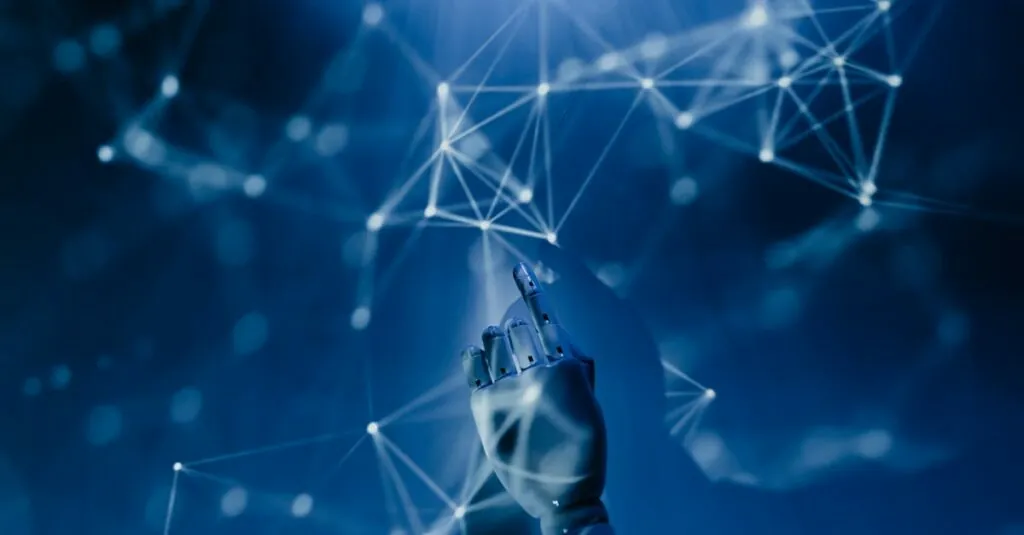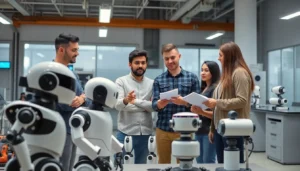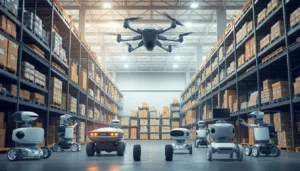In a world where robots are slowly taking over the mundane tasks we dread, it’s hard not to feel a mix of excitement and trepidation. Imagine a future where your coffee brews itself and your laundry folds with a cheerful beep. Robotics and automation are not just sci-fi fantasies; they’re reshaping industries and redefining the way we live and work.
Table of Contents
ToggleOverview of Robotics and Automation
Robotics and automation encompass a vast array of technologies designed to enhance efficiency and precision across various sectors. These advancements enable machines to perform tasks that were once exclusively human, significantly changing workflows in manufacturing, healthcare, and other industries.
Industrial robots, for example, efficiently execute repetitive tasks such as assembly and welding, resulting in increased production rates. Emerging technologies such as collaborative robots or cobots work alongside humans, amplifying productivity without replacing jobs.
Additionally, automation plays a key role in data processing and analysis. Automated systems can identify patterns and insights from large datasets faster than manual methods. This capability drives informed decision-making in businesses and organizations.
In healthcare, robotics aids in surgeries and patient care. Robotic surgical systems allow for minimally invasive procedures, improving recovery times and patient outcomes. Assistive robots help the elderly with daily activities, enhancing their quality of life.
Moreover, advancements in artificial intelligence (AI) integrate with robotics, enabling machines to learn from their environments and adapt to new tasks. This fusion of AI and robotics positions industries for unprecedented efficiency and innovation.
According to the International Federation of Robotics, global sales of industrial robots reached 384,000 units in 2020, marking a 19% increase from the previous year. The automation market is projected to reach $500 billion by 2025, indicating a robust growth trajectory.
With these developments, the future of robotics and automation promises transformative effects on everyday tasks and overall industrial capability. As technology continues to evolve, its integration into daily life is set to become even more profound.
Key Technologies in Robotics and Automation
Robotics and automation rely on several key technologies that drive their functionality and innovation.
Artificial Intelligence
Artificial intelligence plays a critical role in robotics by enabling machines to perform complex tasks independently. AI algorithms analyze data, allowing robots to recognize patterns and make decisions in real time. The integration of AI enhances robotic capabilities, particularly in environments requiring adaptability, such as manufacturing and healthcare. For instance, robots equipped with AI can navigate unpredictable conditions and optimize processes without human intervention. This technology is essential for creating smart systems that learn from experience, improving efficiency and precision across various applications. Companies are increasingly adopting AI-driven robots, which enhances productivity and reduces operational costs.
Machine Learning
Machine learning is a subset of artificial intelligence that focuses on enabling robots to learn from data. By employing algorithms, machines adjust their operations based on historical data, effectively improving their performance over time. Enhanced accuracy in tasks like quality control and predictive maintenance can stem from this continuous learning process. As robots gather more data from their environment, they become more adept at identifying anomalies and predicting outcomes. Industries such as automotive and logistics significantly benefit from machine learning, as these technologies minimize errors and maximize efficiency. The ongoing advancements in machine learning directly contribute to the overall growth of robotics and automation technologies.
Applications of Robotics and Automation
Robotics and automation play crucial roles across various industries, enhancing efficiency and productivity.
Industrial Automation
Industrial automation utilizes robotic systems to improve manufacturing processes. Robotics performs repetitive tasks with high precision, reducing error rates. Global demand for industrial robots increased significantly, with 384,000 units sold in 2020. Companies implement automated assembly lines for faster production and cost reduction. These systems enhance work safety by handling hazardous materials and tasks. Real-time data collection allows for better monitoring and adjustments during production, ultimately leading to improved product quality.
Healthcare Robotics
In healthcare, robotics enhances surgical procedures and patient care. Surgical robots assist surgeons in performing complex operations with greater accuracy. Such technology minimizes patient recovery time and reduces hospital stays. Robots also provide vital assistance to the elderly, helping with daily tasks and monitoring health conditions. Telepresence robots enable remote consultations, expanding access to healthcare services. As the healthcare sector evolves, robotics will continue to improve the quality of care and operational efficiency.
Autonomous Vehicles
Autonomous vehicles revolutionize transportation with their advanced technologies. These vehicles use artificial intelligence for navigation and obstacle detection, leading to safer roads. The global market for autonomous vehicles is projected to grow substantially, with advancements in machine learning enhancing their performance over time. Companies invest in testing autonomous vehicles for public transport and logistics, reducing human error and operational costs. As technology progresses, adoption of autonomous vehicles may transform urban mobility and freight delivery.
Benefits of Robotics and Automation
Robotics and automation deliver numerous advantages across various sectors. Efficiency increases significantly when robots handle repetitive tasks, allowing human employees to focus on complex issues. Precision improves in manufacturing processes, leading to reduced waste and higher product quality.
Cost reduction plays a vital role in the adoption of automation technologies. Businesses witness lowered operational expenses as robots streamline processes and minimize errors. Timesaving also stands out as automation speeds up tasks that traditionally required substantial manual effort.
Safety enhances in workplaces where robots assume hazardous jobs. This shift decreases the risk of injuries, promoting a healthier work environment. Collaboration emerges as another benefit, with cobots working alongside humans to augment productivity without replacing jobs.
In healthcare, robotics led to surgical precision improvements. Surgeries that once took hours now occur more efficiently, reducing recovery time for patients. Robotics adds value by assisting the elderly, providing support that enhances daily living.
Autonomous vehicles illustrate the transformative nature of robotics and automation. These vehicles utilize AI for navigation, which reduces human error significantly and improves transportation efficiency. Increased data processing capabilities elevate decision-making, allowing organizations to adapt quickly and respond effectively.
Market growth showcases the impact of robotics and automation, with industry projections suggesting the automation market may reach $500 billion by 2025. The presence of 384,000 industrial robot units sold in 2020 highlights the growing reliance on these technologies. Embracing automation is essential for businesses striving to stay competitive in an evolving landscape.
Challenges and Considerations
Robotics and automation present several challenges that require attention. Increased reliance on these technologies can lead to job displacement for specific roles. Some workers, particularly in manufacturing and service sectors, face significant risks as robots take over repetitive tasks.
Ethical considerations arise with autonomous systems. Decision-making processes in AI create concerns about accountability when machines make errors or unintended decisions. Addressing these issues is vital for fostering public trust in robotic solutions.
Integration of robotics into existing infrastructure poses technical challenges. Businesses often need to invest heavily in upgrading their systems to accommodate new technologies. Adaptation periods may cause temporary disruptions in workflow, potentially affecting productivity.
Data security becomes critical as technology evolves. Robots and automated systems collect vast amounts of data, increasing vulnerability to cybersecurity threats. Ensuring robust data protection measures is essential for safeguarding sensitive information.
Regulatory frameworks lag behind technological advancements. Policymakers struggle to establish guidelines that promote innovation while ensuring safety and compliance. Encouraging collaboration between industry leaders and regulators fosters a proactive approach to addressing emerging issues.
Costs involved in implementing robotics present a barrier for smaller businesses. While large corporations can absorb expenses, small and medium enterprises may find it challenging to invest in such technologies. Support programs can help level the playing field, promoting broader adoption.
Lastly, public perception plays a significant role in the acceptance of robotics. Misconceptions regarding job loss and safety concerns can hinder acceptance. Effective communication and education about the benefits of robotics are necessary for fostering a positive outlook.
Robotics and automation are reshaping the landscape of daily life and industry. As these technologies become more integrated into various sectors they promise enhanced efficiency and improved quality of life. The potential for robots to assist in both mundane tasks and complex operations opens up exciting possibilities for the future.
However the journey isn’t without its hurdles. Addressing job displacement ethical concerns and cybersecurity threats is crucial for fostering a positive perception of these advancements. By navigating these challenges thoughtfully society can harness the full potential of robotics and automation while ensuring a balanced coexistence with human workers. The future is bright for those willing to embrace change and innovation.










